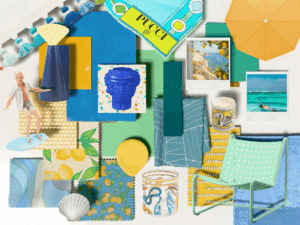This how-to guide will demonstrate how to render a wall elevation.
How to render drawings – part 6 of 6
Rendering a wall elevation
On this elevation we will be showing a combination of 2 window treatments and a wallpaper design. The wallpaper that has been chosen for this room is plain in colour but has a vertical and horizontal grain woven into it.
As this elevation relates to the same room, the colours therefore will be similar, meaning that the existing pre-blended colours can be used again. Using the pre-blended brown a small amount of yellow can now be added to achieve a warmer tone of colour to represent the wallpaper. You may find it helpful to mask off the curtains as this will help to keep them clean. The colour can now be applied all over the wall, paying particular attention to the corners of the room near the floor and near the ceiling. Textured detail can be added towards the end of the drawing.
The detail of the glass can now be added using the same technique demonstrated earlier. Remember to drag the putty rubber across the window to represent the reflection of the glass. To match the white, high gloss finish of the furniture, the window pane is also painted white. Acrylic paint applied directly with a brush is the best way to achieve this look. Using a watercolour pencil in a lighter shade of grey can then represent shadows that may appear on the frame. This can then be blended with a damp brush.
The blinds are made up of individual, horizontal slats of wood so you need to apply colour to these separately. The wooden venetian blinds have been chosen to match with the warm, light, oak flooring. Try using 2 or 3 watercolour pencils in similar shades to create the effect of the grain. Use a plain piece of paper to protect the area of the drawing that has already had colour added to it. Once again, use a damp brush to bring out the colour and help blend these together.
The fabric that has been chosen for the double pleat floor length curtains is a carky green wool mix. To achieve this colour, use the existing brown that has already been mixed but add a small amount of green until you achieve the desired shade. You may find it easier to turn the drawing around, covering one half of the window with plain paper to protect the details. Using a cotton wool ball or bud, whichever you find easiest, start to apply the colour down the full length of the curtain, remembering to build up the layers as you go along. Where the fabric has been pleated at the heading of the curtain, build up the depth of the colour as the fabric will have more shading in this area.
Select a watercolour pencil in a suitable shade of green and use this to add in occasional vertical lines to represent how the fabric will hang in folds. Take care not to add in too many otherwise the fabric will start to look striped. Use a fine, damp brush to blend these lines into the main colour used for the curtains.
Once you are happy with these details, you may want to apply a little bit more of the pre-blended pastel chalks over the top using a small cotton wool ball just to finish off. A watercolour pencil is recommended when rendering the pole as these details are more delicate. Apply colour to the pole, finials and rings and then use a fine, damp brush to help bring out the colour.
The skirting board is also white to match the window frame. Use the putty rubber to remove any unwanted pastel chalks that may have appeared in this area whilst rendering your drawing. A pale grey watercolour pencil can now be used to introduce shadows across the top of the skirting and in the area where the curtains hang in front of the skirting. This can then be blended with a damp brush to soften the effect.
The drawing is nearly finished now so we can go back and add in the delicate details to represent the grain of the wallpaper. This is usually applied towards the end of the drawing as it’s much easier to determine how much detail is required to ensure the whole drawing looks balanced.
Select a watercolour pencil in a shade slightly darker than the base colour. Make sure this is sharpened so you can achieve a clean crisp line. Starting at the top, using a ruler, start to draw in horizontal lines, these don’t need to run across the full width of the wall, but can vary in length and start in different areas, but they do need to be drawn closely together. You may find it easier to divide the drawing into sections when adding in these lines, as you can see in the tutorial. Avoid applying too much pressure as these lines need to look delicate.
Once all the horizontal lines have been added, you can now introduce vertical lines using the same technique. Once these have been added, the effect you have achieved is that of a woven, textured wallpaper.
We hope that you have enjoyed watching these short videos and now feel confident to practice and apply these techniques to your own collection of drawings.
To find out more about our workshops and courses, visit our website www.nda.ac.uk where you will also be able to access our online art shop where many of the materials used in these videos can be purchased.


2 responses
Pretty good post. I just stumbled upon your blog and wanted to say that I have really enjoyed reading your blog posts. Any way I’ll be subscribing to your feed and I hope you post again soon.
Wooden Blinds
These videos are so useful – wish I had known about you before I booked a course with another provider 🙁